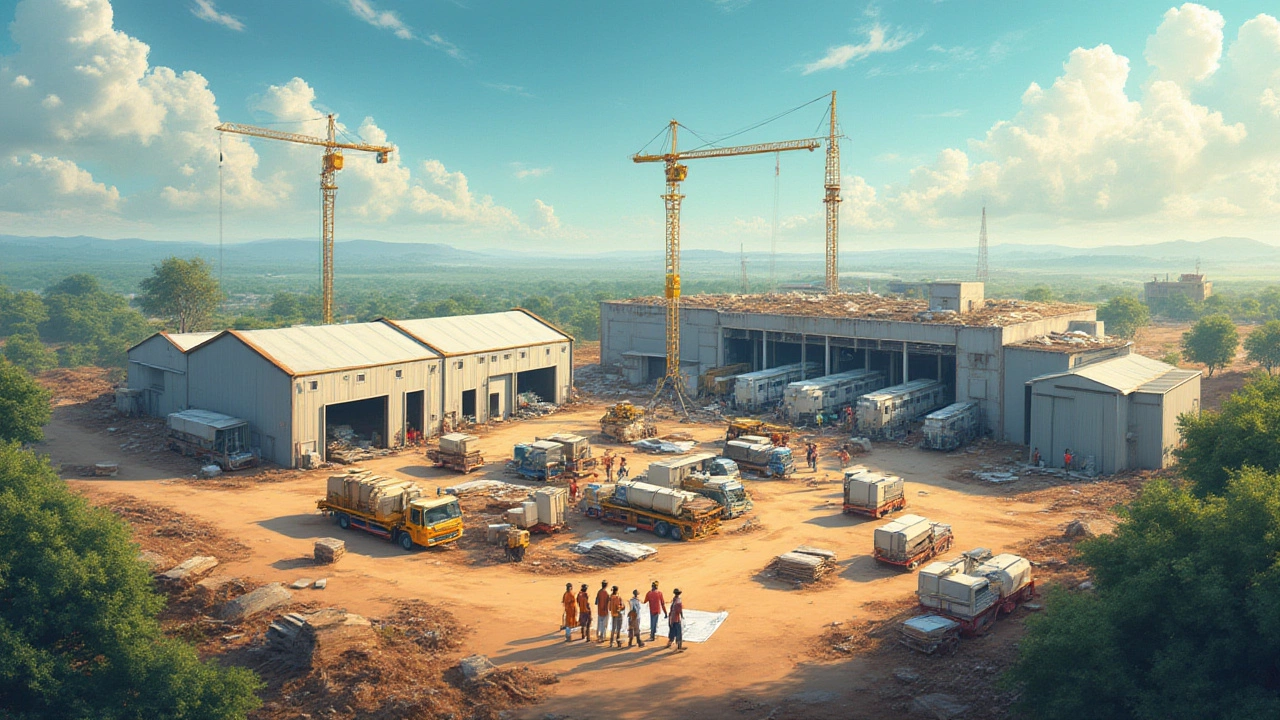Every year, hundreds of hopeful entrepreneurs dream of making it big in India's massive textile industry. It's no shocker—the sector feeds millions of mouths, powers rural towns, and pumps out everything from soft bedsheets to runway-ready saris. But here’s the thing most folks don’t tell you: just thinking about "how much does it cost to start a textile factory in India" barely scratches the surface. Numbers can swing wildly, and the real bill rarely matches what you see on ‘inspirational’ YouTube channels. I’ve met people who launched on a shoestring, and others who got swamped within months. So, if you want to know the true cost—without the marketing pitch—this is your playbook.
How Much Money Do You Need? Breaking Down the Core Startup Costs
Buckle up, because this isn't a fixed number like grabbing a latte. Setting up a textile factory means playing with a ton of moving pieces, from spinning machines that look like props out of a sci-fi movie, to boring but essential paperwork (thanks, government red tape). Your core costs fall into a few huge buckets—let’s break them down with ballpark numbers, but remember: location, scale, and product type (spinning, weaving, garment, or finishing) will tweak your figures.
| Expense Category | Entry-Level (INR) | Mid-Scale (INR) | Large-Scale (INR) |
|---|---|---|---|
| Land & Factory Building | 50 lakhs | 2.5 crores | 10+ crores |
| Machinery & Equipment | 70 lakhs | 3 crores | 20+ crores |
| Raw Materials (Initial Stock) | 10 lakhs | 75 lakhs | 5 crores |
| Licensing & Compliance | 2 lakhs | 10 lakhs | 40 lakhs |
| Utilities & Installations | 5 lakhs | 30 lakhs | 2 crores |
| Labor (First 6 Months) | 12 lakhs | 60 lakhs | 3 crores |
| Marketing & Miscellaneous | 4 lakhs | 25 lakhs | 1 crore |
Here’s a quick dose of reality: if you want to test the waters with a tiny setup, you might squeak by with around 1.5 to 2 crore rupees. Most serious players, though, start from 7 crores and blast past 30 crores for a decent-sized operation that runs year-round and meets export standards. Thinking of going big and selling to Zara or IKEA one day? Then 50 to 100 crores is your entry ticket. If you’re planning a powerloom or simple garment unit, you can get in for less than a spinning and weaving combo, but you’ll face mad competition and finer margins.
Some pro tips:
- Land costs can eat half your budget in cities like Surat or Tiruppur, but shrink by 60% if you pick a rural textile park or industrial zone.
- Chinese machines often cost 20-40% less than Western versions, but warranty and repair can be a pain. On the flipside, Indian manufacturers have caught up surprisingly fast in quality.
- Most newbies forget to budget for power backup. When state grid drops (and it will), you don’t want a day’s output ruined.
The Hidden Costs Nobody Warns You About
It’s easy to get dazzled by big machines and clean factory sheds, but some gnarly costs lurk in the shadows. For one, raw material prices jump up and down like crazy. Have a sudden surge in cotton or polyester? Your working capital gets squeezed. Smart factory owners always keep a cash buffer—think of it as your rainy-day fund against global price shocks.
Then there’s pollution control and compliance—a monster you can’t ignore. Pollution Control Board permissions, effluent treatment plants, and environment impact fees won’t just hit your pocket. Messing up here risks your license. In 2023, Tiruppur’s dyeing units saw 50% temporary shutdowns due to untreated discharges, costing crores in lost contracts. That’s not just a local scare; states like Maharashtra and Gujarat have gotten strict too. Plan on at least 5 to 10% of total plant cost just for staying legal and safe. Modern effluent plants for medium-sized units cost between 30 lakhs to 1.5 crore, depending on output type and volume.
Staff retention is another hidden sinkhole: training skilled workers isn’t fast or cheap. In places like Tamil Nadu, skilled machine operators jump factories for a 10% hike. Overtime and peak season bonuses must be budgeted up front. Automation can help, but robots have their own sticker shock.
Don’t forget logistics, either. If your buyers are in Mumbai and your plant is in a far-off village, add up to 3% to your transportation costs. B2B buyers are sticklers for fast delivery—slow shipments lose orders and eat into margins. Insuring raw material, in-transit stock, and finished goods? Again, often skipped, but one fire or accident can set you back months.

Regulatory Maze: Licenses, Permissions, and Red Tape
This part’s enough to raise your blood pressure. Licensing in India isn’t ‘one and done.’ Here's what most folks juggle:
- Company Registration (Private Limited, LLP, or Partnership): 10,000 to 50,000 INR
- GST Registration: Free if DIY, else 5,000-10,000 INR through an agent
- Trade License (Municipal): 5,000 to 50,000 INR per year
- Factories Act Registration: 20,000 INR+ (varies by State)
- Fire Safety Clearance: Varies massively, often tied to building cost; 10,000 to 2 lakhs INR
- Pollution Control Board Clearance: Hefty, and ongoing (application fee plus annual compliance)
- Labour Welfare Fund & Social Security Registration
- Import/Export Code (for foreign trade): 5,000 to 15,000 INR
- Power Connection and Electricity Board NOCs
Here’s a killer tip—textile parks or clusters in several Indian states offer a "single window" system. You still need all the paperwork, but government nods come faster and you might grab subsidies of 15% to 35% on machinery or infrastructure. Example: Developers in Gujarat’s Mandvi textile park saw up to 25% capital subsidy, plus power tariff concessions for the first five years. Just read the fine print. Some states throw in training grants per worker—handy if you’re hiring dozens at once.
Word on the street: new ESG norms (Environmental, Social, and Corporate Governance) are pushing large buyers to demand clean, compliant, and ethically run factories if you want their orders. Don’t drag your feet—setting compliance baselines now will make you a preferred vendor later.
Maximizing Return: Smart Tips and Industry Facts for New Textile Entrepreneurs
India’s textile sector is hungry for innovation. Here are ways sharp founders make every rupee stretch further—even as upfront costs stay steep:
- Start niche and scale: Instead of copying big names, focus on specialized fabrics, organic cotton lines, or sportswear. Demand for eco-friendly and functional textiles is skyrocketing among export buyers.
- Location hacks: Look beyond the usual suspects (Tiruppur, Surat, Ludhiana). Some states, like Telangana, are rolling out land at 60% of market rate, plus electricity at subsidized tariffs for five years for new setups.
- Leverage automation: A single automated loom can do the work of three operators—saving up to 30% payroll in the long run, even if upfront price stings.
- Tap into skill-building programs: The Ministry of Textiles funds on-the-job training—apply early and save on recruitment costs.
- Bulk-buy discounts: Negotiating joint supplies with nearby units slashes yarn and chemical costs, especially for smaller players.
Textile factory cost India is also about survival after launch. Expect your break-even to take two to four years. Government data from early 2024 shows 63% of new mid-sized textile units struggled in the first twelve months before hitting steady sales, mostly due to underestimating raw material volatility and labor churn.
Here’s something people hardly talk about: Community reputation matters. In places like Erode and Panipat, word-of-mouth wins more contracts than any billboard. Treat your workforce well, pay on time, and local lenders actually offer better loan terms since your repayment risk drops.
Last big fact: India’s textile exports hit 44 billion USD in 2023, up 13% from last year, but domestic demand is set to double by 2028. There’s room for bold minds, but the bar for quality, speed, and compliance has shot up. If you can juggle costs, battle bureaucracy, and keep your machines running through blackouts, you’ll carve your slice of this booming industry.

